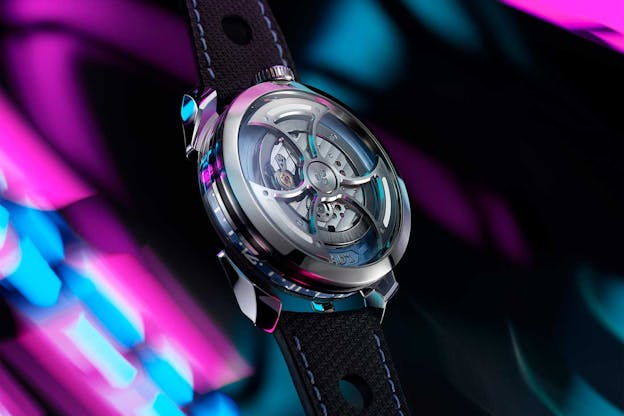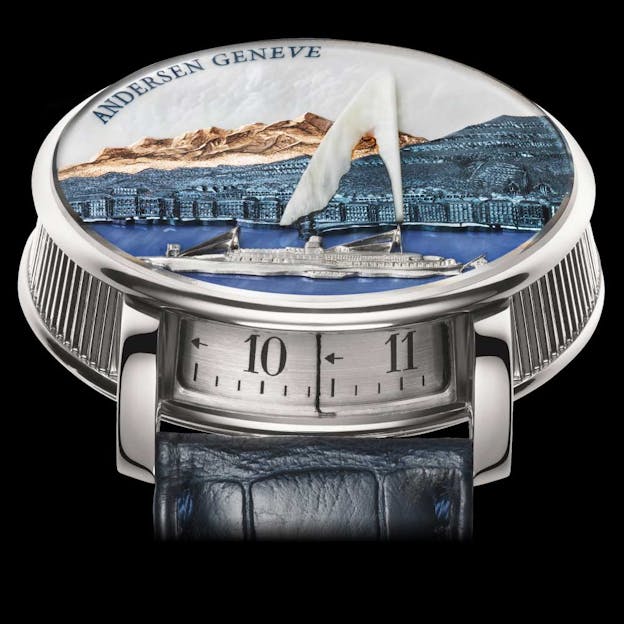Introducing The M.A.D. Editions M.A.D.1S, The Latest Watch From M.A.D. Editions
A fine M.A.D.ness.
One of the most interesting things about MB&F is the degree to which the company has reinvented itself, ever since HM1 was released all the way back in 2007. There are to date, a total of 11 Horological Machines and 12 Legacy Machines, and that’s not counting the so-called Performance Pieces, clocks, and variants and sub-variants across all the product families. The only thing more remarkable than the sheer diversity of MB&F’s designs – and it’s worth remembering that often, a new model means a completely new movement – is the fact that you can look at just about any timepiece that MB&F has ever produced, clock or watch, and recognize it instantly as an MB&F design.
Remarkably enough, one of the most talked-about MB&F watches of the last three or four years has not, strictly speaking, been an MB&F watch at all. The M.A.D.1, which was first launched in June of 2121, is not an MB&F timepiece – instead, it was produced under the aegis of the M.A.D. Gallery in Geneva, which is Max Busser’s showcase and gallery for a very wide and wild range of kinetic mechanisms, some of which are are timepieces, and some of which are not. M.A.D. stands for Mechanical Art Devices, so the brief is pretty broad, but there’s an obvious common sensibility connecting all the works of art the Gallery shows. The first M.A.D. watch did not have an official launch – it was originally introduced as a more affordable horological design, which was made available to MB&F’s “friends” which is to say the suppliers and designers who had made the preceding MB&F watches possible.

The first M.A.D.1 was not offered to the larger collecting community, but the larger collecting community definitely wanted it; there is nothing like telling a collector they can’t have something to make them want it even more. In March of 2022, the M.A.D.1 Red became the first M.A.D.1 offered to the general public – all the M.A.D. watches are part of the larger M.A.D. Editions family – and with the M.A.D.1S, we’re now into the fifth M.A.D.1 watch (with a M.A.D.2, says MB&F, on the horizon).

The new M.A.D.1S is a slimmer, somewhat simplified version of the preceding M.A.D.1 watches. Those familiar with the M.A.D.1 releases will notice first of all, that while the M.A.D.1 watches tell the time on two cylinders visible through the case flank – one for the hours and one for the minutes – the new M.A.D.1S has one cylinder, for the hours. The reason for this is to produce a thinner, more versatile, and, depending on your wrist size and personal tastes, more wearable version of the design, although the M.A.D.1S is still clearly a M.A.D.1 model. The case diameter is the same as with the previous models – 42mm in diameter – but the thickness is slimmed down, from 18.8mm to 15mm, which is a pretty major reduction in height.

The overall case construction is similar to preceding models as well – the movement and hour ring sit inside a container-like caseback, with four lugs projecting out past the edges of the case proper. The movement is essentially inverted inside the case, with the winding rotor visible through the upper domed sapphire crystal. The hour ring looks like it’s driven off the center wheel, in the center of the movement, which rotates once per hour.

Reading the time to within the minute isn’t really possible but at the same time, you can estimate it pretty closely – it’s around 7:35 or so in the image above. The idea of making a watch with a rotating ring for the hours that’s read via an aperture in the case has been used before – most notably, as far as I can recall, by Svend Andersen, in his Montre à Tact, which was introduced in 2015 – Andersen made a unique piece for Only Watch 2019 on this system, with an enamel case top showing Geneva’s famous landmark, the high-spouting foutain called the Jet D’Eau, which began life as a pressure release valve for a hydroelectric station. (We can’t all have Eiffel Towers, I guess).

Andersen called his take on this time display a “Montre à Tact” which means “tactful watch,” the idea being that you could glance at the time without noticeably turning your wrist and calling attention to the fact that you were wondering (for instance) when a meeting or other tedious conversation was going to end.
The M.A.D.1 and M.A.D.1S watches are on the other hand, not pursuing the goal of letting someone read the time surreptitiously – with the triple blade rotor spinning under the upper sapphire crystal, this is not a watch likely to pass unnoticed. One among many differences between Andersen’s take on the design, and what you see in the M.A.D.1S, is that in the latter, the entire periphery of the case is transparent so you can see the hour ring turning from any angle. The rotor, as in previous M.A.D.1 models, has three luminous tubes set along the edge of each of the blades, and as with previous models, the hour ring numerals and markers, as well as the case flank pointer for reading off the time, are filled with lume as well.

The movement is the other big change from the first four M.A.D.1 models – those used a modified Miyota caliber 8315; the new M.A.D.1S uses a La Joux Perret caliber G101, which is the no-date version of LJP’s G100, which is a drop-in replacement, at least in terms of dimensions, for the ETA 2824. The LJP G100/101 was introduced in 2021, and it’s been used since then by, among others, Furlan Mari and Anordain; a reliable movement with a 68 hour power reserve. Since it’s inverted in the M.A.D.1S, the rotor isn’t the only kinetic element visible through the upper sapphire; you can also see the balance, ticking away at 28,800 vph.

There are meaningful and very real versions to consider the M.A.D.1 watches a separate category from those produced by MB&F, but of course, they’re not not MB&F watches either (except in the price, which for all four models has been under CHF 3000; at CHF 2900, this is the most expensive M.A.D.1 model so far but with the upgrade to the movement, plus the overall level of design and execution, I think you’re getting a bargain to put it mildly, assuming you can get one – there will be 1500 pieces allocated by raffle in the first production batch, although this is not a limited edition per se. The connection with MB&F is of course, immediately obvious and obviously intentional; the rotor, to pick just one design element, is a three bladed version of the famous MB&F manga-inspired Double Battleaxe rotor, which was used as far back as HM1.

In a way, I miss the more assertive three-dimensionality of the first four M.A.D. editions, although I’m hesitant to call this a refinement – it seems more a variation on the overall theme rather than an attempt to improve as such, on anything in particular. The trope of inverted movement architecture is one I’m generally not awfully fond of, which may just be force of habit on my part, but I usually feel as if such watches struggle to succeed as design efforts. I don’t think that’s so in this case – like its predecessors, the M.A.D.1S shows just how successful an alternative to business as usual can be; it also shows that such success is something you have to work for. It’s a testament to the evolution of design at M.A.D. Editions and MB&F, that the M.A.D.1S makes it look easy.
The M.A.D.1S: Case, 316L stainless steel, 42mm x 15mm, water resistance 30M; mineral glass back and domed sapphire front crystal with double-sided AR coating. Movement, Manufacture La-Joux Perret caliber G101, beating at 28,800 vph with 68 hour power reserve. Unidirectional winding (which makes for some very dynamic rotor rotation). Available to Friends (suppliers) and Tribe (MB&F collectors) in a limited series with purple accents; for the general public, ice-blue accents. 1500 piece first series; price, CHF 2900. To register interest and enter the lottery, visit the M.A.D. Gallery. You gotta be in it to win it.

